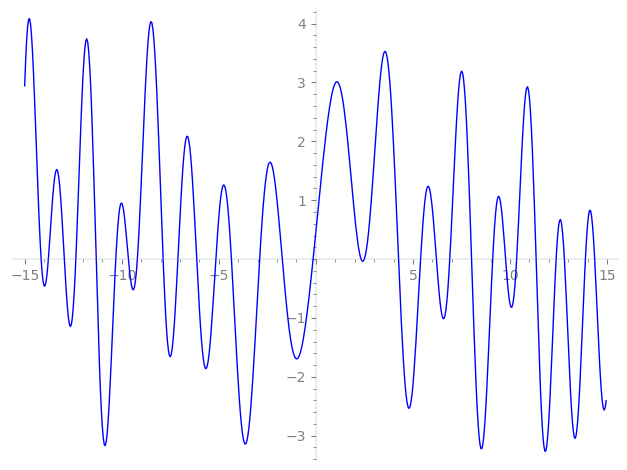| L(s) = 1 | + (5.19 − 3i)5-s + (−3.5 − 6.06i)7-s + (−2.59 − 1.5i)11-s − 22·13-s + (−20.7 − 12i)17-s + (5 + 8.66i)19-s + (−25.9 + 15i)23-s + (5.5 − 9.52i)25-s + 33i·29-s + (6.5 − 11.2i)31-s + (−36.3 − 21i)35-s + (5 + 8.66i)37-s + 30i·41-s + 56·43-s + (−24.5 + 42.4i)49-s + ⋯ |
| L(s) = 1 | + (1.03 − 0.600i)5-s + (−0.5 − 0.866i)7-s + (−0.236 − 0.136i)11-s − 1.69·13-s + (−1.22 − 0.705i)17-s + (0.263 + 0.455i)19-s + (−1.12 + 0.652i)23-s + (0.220 − 0.381i)25-s + 1.13i·29-s + (0.209 − 0.363i)31-s + (−1.03 − 0.599i)35-s + (0.135 + 0.234i)37-s + 0.731i·41-s + 1.30·43-s + (−0.499 + 0.866i)49-s + ⋯ |
\[\begin{aligned}\Lambda(s)=\mathstrut & 756 ^{s/2} \, \Gamma_{\C}(s) \, L(s)\cr =\mathstrut & (-0.997 - 0.0633i)\, \overline{\Lambda}(3-s) \end{aligned}\]
\[\begin{aligned}\Lambda(s)=\mathstrut & 756 ^{s/2} \, \Gamma_{\C}(s+1) \, L(s)\cr =\mathstrut & (-0.997 - 0.0633i)\, \overline{\Lambda}(1-s) \end{aligned}\]
Particular Values
| \(L(\frac{3}{2})\) |
\(\approx\) |
\(0.4693117253\) |
| \(L(\frac12)\) |
\(\approx\) |
\(0.4693117253\) |
| \(L(2)\) |
|
not available |
| \(L(1)\) |
|
not available |
\(L(s) = \displaystyle \prod_{p} F_p(p^{-s})^{-1} \)
| $p$ | $F_p(T)$ |
|---|
| bad | 2 | \( 1 \) |
| 3 | \( 1 \) |
| 7 | \( 1 + (3.5 + 6.06i)T \) |
| good | 5 | \( 1 + (-5.19 + 3i)T + (12.5 - 21.6i)T^{2} \) |
| 11 | \( 1 + (2.59 + 1.5i)T + (60.5 + 104. i)T^{2} \) |
| 13 | \( 1 + 22T + 169T^{2} \) |
| 17 | \( 1 + (20.7 + 12i)T + (144.5 + 250. i)T^{2} \) |
| 19 | \( 1 + (-5 - 8.66i)T + (-180.5 + 312. i)T^{2} \) |
| 23 | \( 1 + (25.9 - 15i)T + (264.5 - 458. i)T^{2} \) |
| 29 | \( 1 - 33iT - 841T^{2} \) |
| 31 | \( 1 + (-6.5 + 11.2i)T + (-480.5 - 832. i)T^{2} \) |
| 37 | \( 1 + (-5 - 8.66i)T + (-684.5 + 1.18e3i)T^{2} \) |
| 41 | \( 1 - 30iT - 1.68e3T^{2} \) |
| 43 | \( 1 - 56T + 1.84e3T^{2} \) |
| 47 | \( 1 + (1.10e3 - 1.91e3i)T^{2} \) |
| 53 | \( 1 + (36.3 + 21i)T + (1.40e3 + 2.43e3i)T^{2} \) |
| 59 | \( 1 + (85.7 + 49.5i)T + (1.74e3 + 3.01e3i)T^{2} \) |
| 61 | \( 1 + (-47 - 81.4i)T + (-1.86e3 + 3.22e3i)T^{2} \) |
| 67 | \( 1 + (-38 + 65.8i)T + (-2.24e3 - 3.88e3i)T^{2} \) |
| 71 | \( 1 + 18iT - 5.04e3T^{2} \) |
| 73 | \( 1 + (-27.5 + 47.6i)T + (-2.66e3 - 4.61e3i)T^{2} \) |
| 79 | \( 1 + (41.5 + 71.8i)T + (-3.12e3 + 5.40e3i)T^{2} \) |
| 83 | \( 1 + 147iT - 6.88e3T^{2} \) |
| 89 | \( 1 + (114. - 66i)T + (3.96e3 - 6.85e3i)T^{2} \) |
| 97 | \( 1 + 85T + 9.40e3T^{2} \) |
| show more | |
| show less | |
\(L(s) = \displaystyle\prod_p \ \prod_{j=1}^{2} (1 - \alpha_{j,p}\, p^{-s})^{-1}\)
Imaginary part of the first few zeros on the critical line
−9.657765808279198648779914938304, −9.196665271373130453980366769776, −7.86986045716002037241097299399, −7.10823172523815618241243563649, −6.13868080720662940039987734090, −5.15356285676626124793402528171, −4.35085021142025201504763565105, −2.89777301827828677023054571814, −1.73052250387358553602277616939, −0.14325642354106966165098811189,
2.32503713474118063772007082654, 2.49445162020082555137753706006, 4.25571909906297655962343257664, 5.39265965990306307362080069035, 6.20773514390019345156462865702, 6.89528601860067423520271406538, 8.018465956497466294272103624646, 9.105592681951385648992890427181, 9.770252658739141316768253847016, 10.33999754857988484016681729004

